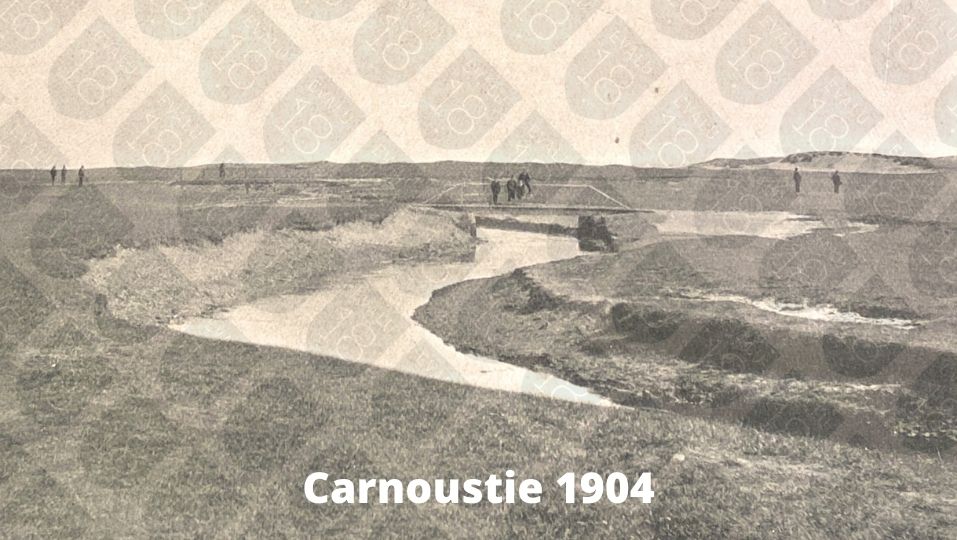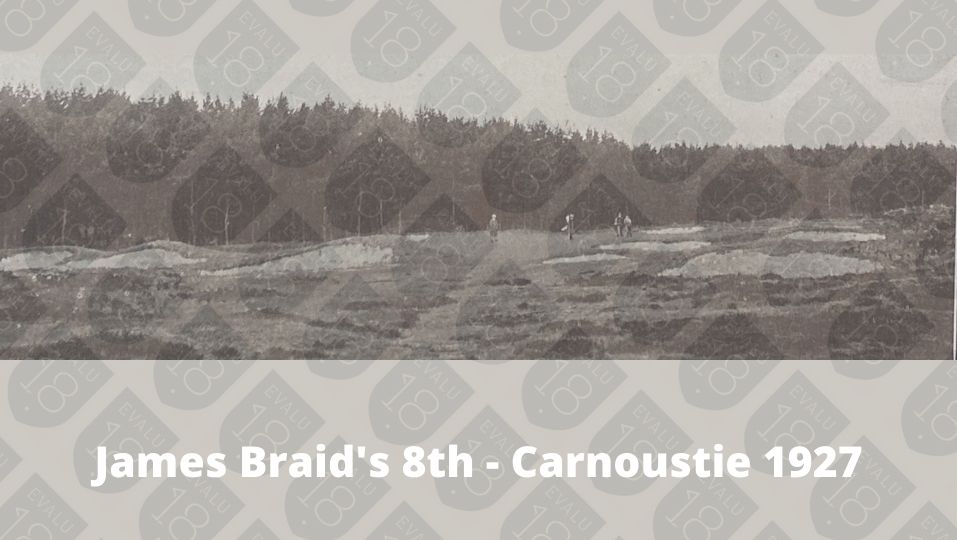Carnoustie Golf Links

Overview
This is serious golf of the highest order. An unassuming sleeping beauty that awakens by greed and a whisper of wind.
- Carnoustie Golf Links is perhaps the best-bunkered links course in the world. With honorable mention to the Company of Edinburgh Golfers.
- Wind direction plays an important role due to routing.
- It is one of the finest examples of GCA.
- Tom Doak recommends golf architecture students pay special attention to bunkering.
The turf is of the finest quality playing both firm and fast. There are essentially two cuts of turf here: green height and the rest. The tee boxes blend seamlessly into the fairway and then into the green complexes. The fairways 'brown out' into thin and whispy fescues. It is links golf perfection.
Prestwick has the Pow Burn, North Berwick the Eli, St Andrews the Swilken but Carnoustie trumps them all with the Barry.
The Ben Hogan connection to the 6th hole is well documented after his exploits during the 1953 Open. It was Gene Sarazen, however, who said in 1939 that "the 6th at Carnoustie played against the wind is the nearest approach to a perfect par 5 in the world."
Carnoustie Golf Links Championship Course has been host to the Men's, Women's, and Senior's Open Championships.
Golf Course Review
The Carnoustie Golf Links Championship Course is 'Golf's Greatest Test'. Host to eight Open Championships, one Ladies British Open, and two Seniors Opens, it is one of the few to complete the trifecta. It has also played host to the World Hickory Open in 2015! Carnoustie Golf Links has become synonymous with golfers who have had their careers defined by the course. Jean Van De Velde, Johnny Miller, Gary Player, and Ben Hogan.
Crow's Nest to Carnoustie to Car-Nasty
The Carnoustie Golf Links logo is one of the most iconic in the game. Legend has it that in 1010 the Danes brought thousands of crows over to the Barry Islands to curse the land before battle. The name "Crow's Nest" in the local Scottish dialect "Craw's Nestie" was corrupted with the passage of time, becoming Carnoustie.
When Carnoustie grew and became a borough they needed a crest and a tree with crows flying overhead was created. This has been adopted by the links and golf club. The tree planted to mark the founding of the town, known as the Dibble Tree, can still be seen in Ferrier Street.
More recently, the reputation of being a torrid test of golf has laid the foundation for the course to be colloquially known as Car-Nasty.
Carnoustie Golf Links Worldwide Influence
About 300 of Carnoustie's sons emigrated across the world and brought the game of golf with them. Their influence can be linked to the Americas, South Africa, and Australia. One, Stewart Maiden, emigrated to America and became the pro at East Lake. There he mentored a young lad by the name of Bobby Jones.
Other notables from the Carnoustie School were Archie Simpson, Willie Smith, Alec Smith, George Low, David Bell, Bob Munro, MacDonald Smith, and James Hepburn.
Carnoustie Golf Links History
Steeped in history, golf has been played here since the 16th century. It was in 1839 that the oldest artisan club was founded as the Carnoustie Golf Club. Originally, Allan Robertson laid out 10 holes. In 1867, Old Tom Morris bumped the number up to 18 and James Braid made it Open worthy in 1926.
Changes to the layout were reported in Golf Illustrated in 1904. Some holes were lengthed and appears a new bunker scheme was approved and implemented. By 1905, it appears significant monies were spent in an attempt to create a 'championship course' and there was dissatisfaction with the changes. The ambition and effort expended on making a good links - great, were not realised.
Carnoustie Golf Links still proved popular, if not to the standard of St Andrews. The relief course was altered in 1906 to alleviate pressure on the main course and then extended in 1910.
In 1926, James Braid and John Stutt designed and respectively rebuilt the links laying the foundation for the course we know today. Just five years later, the club would host its first Open Championship. One feature which was not universally applauded was James Braid's inclusion of centreline bunkers. Braid's Bunker on the 2nd hole is a worthy example that remains until today.
Before the 1936 Open Championship, a reported 60 bunkers at Carnoustie Golf Links were filled. The thought of 60 more bunkers on these intrepid links is mind-blowing.
Carnoustie Golf Links' One-Shot Holes
Carnoustie Golf Links also only sports three one-shot holes as it did after James Braid's work. Don't be fooled, there is still sting in their tails. The 8th has OOB left and despite being called "Short" it is anything but easy. The 13th has a green that runs away from you and you must take the aerial approach with the front of the green being the site of a cavernous bunker. The last of the par 3's is the 16th... a tasty 245-yard par-three that is usually played into the wind. The 16th, 17th, and 18th may just be the hardest stretch of three holes in golf... it certainly is when the wind is blowing and you need to par in to win The Open...
Burns, OOB, and Bunkers
Carnoustie Golf Links is famous for its' burns, Out of Bounds, and bunkering. The burns come into play on the holes: 1, 2, 3, 4, 5, 6, 9, 10, 11, 12, 16, 17 and 18. O.O.B comes into play on 1, 6, 7, 8, 9, 14, and 18.
South America may seem an odd name for the 10th. The story goes this is the spot where a local awoke after his farewell party and before embarking to the New World.
Perhaps the most famous bunkers in golf, after a handful at the Old Course and the 4th at Woking, are the Spectacles on the 14th.
Carnoustie Golf Links' 'U'nique Routing
Carnoustie Golf Links' routing is a U-Shape going out to the far side of the site before tacking back along similar lines. It is so cleverly done, no two holes play in the same direction.
The 17th and 18th is perhaps the most nerve-wracking finish in all of Championship Golf. Distance control in the wind, crisp lies on firm and fast linksland, and the every present Barry Burn is what keeps golfers awake at night... the Burn is described by Frank Pennink as an angry, twisting serpent that contains the venom needed to kill a scorecard.
Carnoustie Golf Links Summary
Carnoustie Golf Links is a championship test that beguiles even the best at the height of their powers, perhaps no other course is as strategic, penal, and heroic as Carnoustie Golf Links Championship Course.
The way Carnoustie Golf Links is presented daily is reathtaking. Craig Boath mentioned the course is prepared and presented as if it were hosting an Open every day. Many course managers make the claim, Craig delivers on it. I have never seen a purer golf course, inland or seaside, in all my travels. It has become the standard by which all links are measured.
Carnoustie Golf Links measures less than 7000 yards from the white, or back, tees. In fact, only one hole measures more than 5oo yards. Two of the three one-shot holes measure about 160 yards. The remainder are hearty two-shot holes that play tough.
The course is not overly long, it's 'fair' in the sense you see what's coming. The exception to that rule is Spectacles if played as a two-shot hole rather than a three-shot hole.
Other than the opening couple of holes you won't see dunes of the Irish or Aberdeen variety. The course has a somewhat inland feel despite being authentic links. There are no real sea views and effectively there are no open vistas for which so many modern courses have gained acclaim. Carnoustie Golf Links is the antithesis of Dumbarnie - and please don't take that in any way as a compliment nor a criticism of either links.
Carnoustie Burnside Course
The Carnoustie Golf Links Burnside Course is a par 68 and comes in at under 6,000 yards even from the back tees. With a generous 3 hours and 46 minutes allotted to play the course, it is the perfect 18 after the tougher Championship Test.
The only par 5 tips the scales at just 490 yards but three of the par 4's come in at over 450 yards. With one par 5, four par 3's, and the balance being par 4's, it is no slouch. Similar to the Championship course, OOB comes into play on the 2nd, 3rd, and 18th. The namesake is earned with burns found on the 1st, 3rd, 4th, 5th, 17th, and 18th.
Although it is the second course at Carnoustie, it is by no means second rate. In fact, it probably suffers from the Championship courses' success. The 11th green is perhaps the most difficult test of the 36. The centreline bunker on 12, the punchbowl on 13, and perhaps a driver to the 228-yard par 3 make this string of holes particularly noteworthy.
Burnside is a great example of what can be found if one is not in a hurry to race to the next course over in Fife or north in Aberdeenshire or The Highlands.
The original relief course was 12 holes. In 1906, Mr. Rettie and Bob Simpson turned 12 holes into 9. They added new tees and bunkers and appointed a greenkeeper to keep the course in order. (Golf Illustrated 1906) By 1910, it was decided the relief course needed to be extended to 18 holes.
Carnoustie Golf Links & The Open
Carnoustie Golf Links is a formidable challenge and always seems to deliver an Open the R&A can be proud of. The following players have been victorious on the hallowed links:
- 2018 - The 147th Open - Francesco Molinari
- 2007 - The 136th Open - Padraig Harrington
- 1999 - The 128th Open - Paul Lawrie
- 1975 - The 104th Open - Tom Watson
- 1968 - The 97th Open - Gary Player
- 1953 - The 82nd Open - Ben Hogan
- 1937 - The 72nd Open - Henry Cotton
- 1931 - The 66th Open - Tommy Armour


Carnoustie Golf Links - Videos
Watch Cookie Jar Golf's Old Tom's Trails

Featured Architect: MacKenzie, Alister
As taken from his book, Golf Architecture, Alister MacKenzie felt the following were essential: The course, where possible, should be arranged in two loops of nine holes. There should be a large proportion of good two-shot holes and at least four one-shot holes. There should be little walking between...











